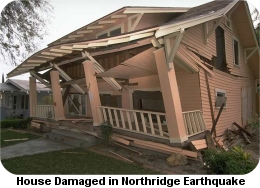![]()

![]()
This especially pleases
FEMA Director James Lee Witt, who is vocal about his support for upgrading
schools because of what happened during the 1994 Northridge, California
earthquake, the most costly in U.S. history. During the earthquake,
unsecured computers, light fixtures, and other heavy objects fell on
students' desks. The students escaped serious injury, and perhaps death,
only because the earthquake occurred at night while the school was empty.

The Northridge earthquake also underscored the importance of giving residents information about making their homes disaster-resistant. While surveying the Northridge damage area, Director Witt met the resident whose house was the only one left standing in his neighborhood after the quake. Why was his home the only one to survive? He was prepared. He'd gone to the local library to learn about earthquake risk reduction measures, and he found FEMA's videotape on the subject of retrofitting homes. He followed FEMA's advice, implemented the earthquake preparedness recommendations, and reaped the benefits.
Berkeley, California is another Project Impact community that is implementing an extensive earthquake preparation and damage prevention program under FEMA's guidance. The destructive Hayward Fault runs beneath Berkeley, so the city has started seismically upgrading every major public building. To help homeowners, Berkeley also contributes money to a fund for residential retrofitting and provides various incentive rebate programs that encourage preventive measures.
![]()
![]()
![]()
Is Your Community
Earthquake-Prone?
While earthquake-prone cities partner with FEMA for community preparedness, individual homeowners in these areas can, and should, take additional actions before a disaster strikes. For example, FEMA recommends the following:
| Anchor homes securely to their foundations, according to engineering specifications. |
| Secure chimneys so they don't break away from the houses. |
| Use anchor eyebolts attached to wall studs to hang heavy items, like mirrors and shelves. |
| Hang heavy items away from beds and places where people sit or lay. |
| Secure light fixtures to the structural support above the ceiling. |
| Secure televisions, computers, and other heavy objects, equipment, and appliances, and fasten tall furniture to wall studs. |
| Strap water heaters to wall studs, and put in flexible gas and water lines. |
| Install cabinet locks and wall straps. |
| Put shatter-resistant film on windows. |
| Assemble an earthquake emergency kit (water, food, radio, flashlight, batteries, medications, first aid supplies, etc.), and keep it in a handy place. |
| Secure ceiling tiles in place over points of exit. |
For more information about earthquakes, visit the National Earthquake Information Center.
For more information about earthquake preparedness and damage prevention (including downloadable earthquake risk maps, suggestions for strengthening homes, and recommendations for reducing potential injury and loss of life and property), visit FEMA's Internet site.
6/12/00